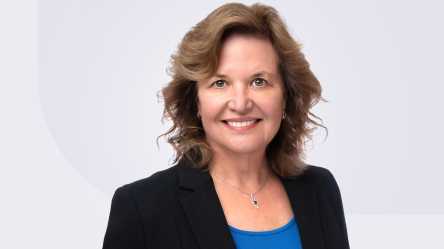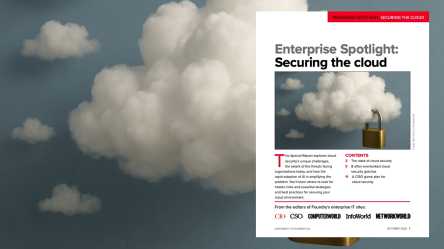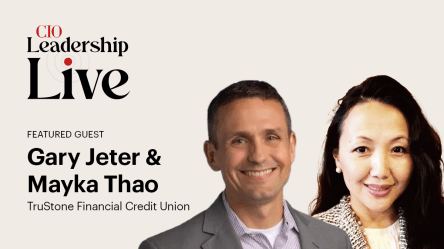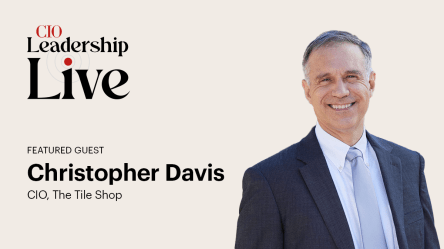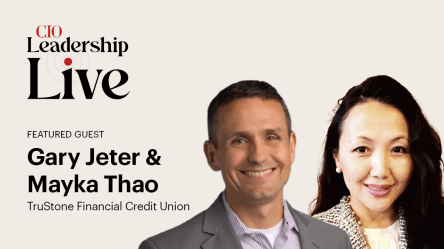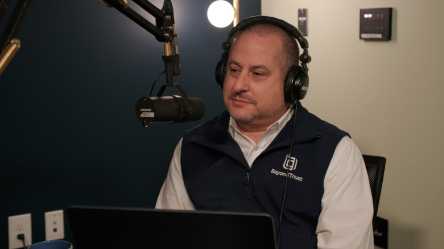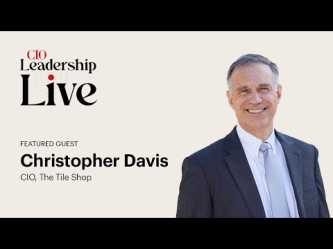Smurfit Westrock Group’s CIO discusses the mindsets and muscles future-ready leaders need to thrive, from leaning into uncertainty as a catalyst for growth to building authentic personal brands.
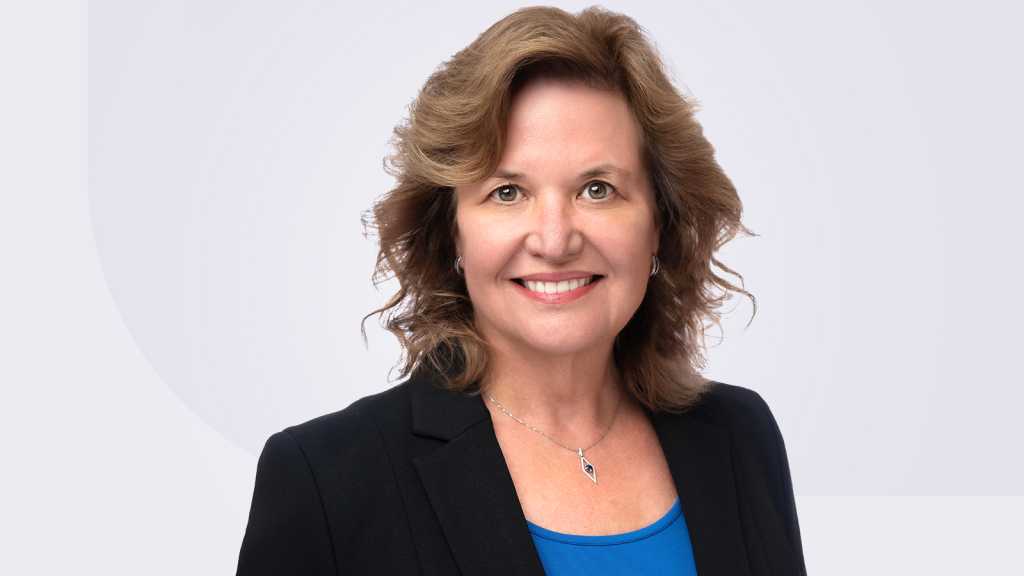
Over the past 20-plus years, Diane Schwarz has built a career across some of the world’s most complex industries, leading top-tier IT organizations with responsibilities for digital transformations, cybersecurity, data analytics, infrastructure and cloud operations, and more. Currently serving as group CIO of Smurfit Westrock, Schwarz leads the strategic and operational aspects of IT at the global sustainable packaging company, overseeing a diverse team of more than 1,500 professionals.
Those who know Schwarz best say she is redefining what it means to be a CIO, with a resilience, agility, confidence, calm, and class that sets her apart. On a recent episode of the Tech Whisperers podcast, we pulled back the curtain on her leadership superpowers and the impact she’s made on the profession.
Schwarz’s career proves that growth comes from being willing to step into roles before you feel prepared for them. For this article, we spent some more time exploring the mindsets and muscles future-ready leaders need to thrive, from leaning into uncertainty as a catalyst for growth to building authentic personal brands. What follows is that conversation, edited for length and clarity.
Dan Roberts: Cardinal Health CIO Michelle Green has said that ‘the land of comfort has no growth.’ What does growth look like as someone progresses within their role?
Diane Schwarz: We often hear people say they want to see somebody perform in a role for six months or a year before promoting them. My view is, we should have confidence that somebody has the potential to learn and grow in the role.
That first year in a role, you’re figuring it out. The second year, you’re delivering. The third year, you’re fixing all the things you didn’t get right in the first two years. Years four and five, if you’re still in the role, you’re digging deep and fixing things and working on strategy, and that’s the really hard part. But no matter how ready you are, you’re still going to go through that first year of learning, that second year of delivering, and that third year of figuring out what you could have done better.
At various points in your career, you’ve taken on roles you didn’t initially think you wanted. What did you learn from those experiences?
I can give two examples of roles I took that I didn’t want. One was when I was coming back into the workforce after I’d had my first child. I’d been in a high-travel role, and at that time in that stage of technology, you really couldn’t be a young working parent and travel full time. So I took a job as manager of budget systems for Nestlé. I was working in the finance team, and I had to run the systems that collected all the budgets and forecasts. How inspiring is that? [laughs] But it got me back in the game, and it eventually got me into project management and SAP. If I wouldn’t have taken the ‘risk’ on the job, I wouldn’t have unlocked all those other opportunities.
Another example is when I took my first role at Bell Helicopter, a subsidiary of Textron. The role was business partner to finance, HR, and legal. How long do you think it took for me to be bored in that role? All of six weeks. How long do you think it took me to influence the CIO at Bell to give me broader scope?
I had to convince my boss I was going to make him more successful and I was going to de-risk his support of this major transformation effort because of the SAP experience I brought to the table that he wasn’t tapping into. But I took that role seeing that Textron was a federated company and I could build a career there. It was about getting a foot in the door and then making the role what I wanted it to be. Eventually that played out; 11 years later I was promoted to global Textron CIO. Sometimes our career moves are a multi-year chess game. You need to make short-term sacrifices to set yourself up for the checkmate move.
What advice would you give to emerging leaders eager to move into their next big role?
I go back to that experience at Bell, where I reframed the scope of what I was going to do, and in the context of de-risking the environment for the CIO. Often I have leaders who want a promotion or new opportunities — for themselves. ‘I want a director title.’ That’s why I should promote you? To give you a director title? What are you going to do? How is this good for the company? How is it you are going to add value? How are you going to make someone else successful?
One of the philosophies I espouse is, if you have the mindset of ‘make others successful,’ it will ultimately reflect back on you and make you successful. I need to have the mindset that I am here to make the senior leadership of Smurfit Westrock — our CEO, our board, our executive committee — successful. If I do, it’s going to come back on improving the brand of IT. And guess what? We can’t make our stakeholders successful if we’re not really doing great things. I think it’s a different way of thinking about servant leadership. Don’t think about your success, think about everybody else’s success, and it just amplifies back on you automatically.
What about the emerging leaders who are waiting for that ‘perfect’ role?
I’ll often hear leaders say things like, ‘I want to wait for this project to finish,’ or ‘I want to be in this role for four years,’ or ‘I want to be able to deliver this final functionality to the business.’ It’s not an individual timeline you need to be following. You need to be following the corporate rhythms, because those opportunities, in the marketplace and in corporate, can dissipate.
At Bell, I was the technical lead on the biggest transformation project they had — the budget was a few hundred million dollars, I had 400 people on my team — and I was given the offer to be a business unit CIO at a much smaller business unit with a staff of 80. The unit was sleepy and didn’t seem to need much transformation, and I thought, really? You want to take me out of the most strategic project across the enterprise and put me over there?
What I didn’t know was, they were grooming me for the top job, and they needed to see me in a business unit CIO role before they’d consider me for the top job. But ‘corporate’ doesn’t often tell you their view of your potential. So I had to have some faith in corporate leadership that there was a path for me, and that it was for the greater good of the company to put me in this other role and deprioritize the good of Bell Helicopter. They basically prioritized the good of Textron over the good of Bell Helicopter by moving me in my career. I couldn’t see that perspective because of where I was positioned in the organization at that time.
Sometimes you need to recognize there are greater movements going on in the companies that you need to take advantage of.
Our profession struggles with the idea of personal branding. Can you describe how you approach what you call ‘authentic personal branding’ and why it’s so important?
It’s a hard topic, because you have to have a lot of years under your belt or wisdom to really understand your brand. If you had asked me 20 years ago to say what my brand was, I’m not so sure I would have had the self-awareness to articulate it.
It’s important to know what your brand is, because your personal brand becomes the brand of the organization you lead. If you don’t have the self-awareness to know your brand, it does a huge disservice to your team. We should all care passionately about our teams and what we deliver, so it’s a blind spot if people don’t want to know about their brand. It means you’re not being vulnerable enough. You’re limiting your team. You’ve got one arm tied behind your back.
One of my mentors guided me on this when I was going into a new company. She said, ‘Find an unlikely voice on the executive committee who you can go to and say, how did I do? What did you see? How can you help me?’ We all have those natural alliances, and she said you need to find those more unlikely alliances, because they’re the ones who can really observe you and give you unbiased feedback so that you know how you are perceived, so that you know what your brand is.
Part of your brand is you’re greatly admired for your resilience, both on a professional and a personal level. Can you talk about how you’ve built that muscle?
I’ll start with the personal side. About two weeks before the pandemic lockdown, I was going through this executive professional development program, and my coach had asked me to define what misery looks like for me. Well, misery is not being able to travel, not being with my teams, not being on the global stage, not being out in the world, going to concerts and theater. Boom, lockdown, and I’m having to live my definition of misery.
So I very intentionally practiced a mindset of gratefulness. I was posting on social media every day as kind of my own accountability mechanism. ‘Today, I am grateful that I can walk my dog.’
Because I had friends in places where their lockdown was so stringent, they couldn’t even leave their apartments. ‘I am grateful for the fact that I have food on my table.’ I would focus on that gratefulness, and it’s like building a muscle, so I got better at it as the pandemic went on.
And then, about a year into the pandemic, my husband had a traumatic brain injury and needed emergency brain surgery. He was in the ICU for a week, and we weren’t sure he was going to come through it. I had to go back to those skills and say, ‘I’m grateful the hospital is only a mile from my house. I am grateful I have a dog-sitter to take care of my dogs while I can be at the hospital. I am grateful that the best trauma surgeon in Dallas-Fort Worth happens to be in our tiny hospital.’ He’s fine and we got through it, but I had to work very hard at that.
When we lost my son a couple of years ago, I had to go back and do those same things. ‘I am grateful for the time that I had with him, grateful for the 29 years,’ not focusing on the end. Every day, every minute, every hour, I had to practice that gratefulness until the muscle built back up. And then once you get into the club of losing a child, you meet all these other people who have lost a child, and you realize how many other people have it way worse than you. That’s when humility comes in. Think about all the parents that lost their children in war and children that didn’t make it to adulthood. Over the last millennia, this has happened billions of times over. The realization hits that I’m not special at all.
That kind of vulnerability and transparency must also help build resiliency in the people around you, because they see that if you can do it, they can do it. What else can you share about building resiliency in your professional life?
Earlier in my career, one of my coping strategies was to say, what is the worst thing that’s going to happen? If this project isn’t on time, if we don’t deliver, if a system crashes, what’s the worst thing that’s going to happen? The business might lose money. We might not make our numbers this quarter. We might lose productivity or miss a shipment. Typically not a life-or-death situation. Typically.
As you start to pull that along, you’re like, okay, ultimately, the worst thing personally that could happen is I get fired. But I will have learned from the situation, and I know the overall experience has been valuable, and I have great marketable skills, so if I lose my job, I can just go get another one. That became my coping strategy, to flippantly think to myself, I might be fired.
Then I had a job working for Sonitrol, which does fire and safety alarm monitoring. If the signals aren’t being processed, if your technology goes down, lives are at stake, because we were dispatching fire and police. So I needed to develop a new coping strategy.
I frequently use the following metaphor when coaching folks on how to not let the stress reach their inner core. We in IT are frequent (constant!) targets of criticism — outages, costs, delivery issues. It can be very tiring. I use the visual metaphor of a bright yellow, rubber, water-repellent raincoat. Think of what Paddington Bear wears. Put the coat on when you walk into the office or budget meeting. Let the mudslinging begin. The coat will shield you. When you leave, take off the coat and hose off the mud, hang it up to dry for tomorrow. Go forward on your merry way, mud free.
For more wisdom from Diane Schwarz’s leadership playbook, tune in to the Tech Whisperers podcast.
See also:


